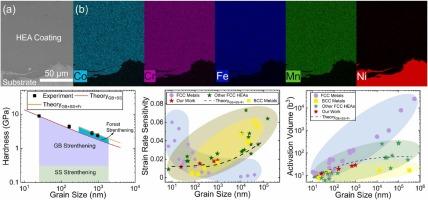FCC高熵合金活化体积和应变率灵敏度的晶粒依赖性
IF 6.3
2区 材料科学
Q2 CHEMISTRY, PHYSICAL
引用次数: 0
摘要
研究了面心立方(FCC)高熵合金(HEAs)在大晶粒尺寸范围内的应变速率灵敏度(SRS)和活化体积。采用一种新开发的机械驱动方法——表面机械合金化和固结(SMAC),合成了一种等原子CoCrFeMn HEA,然后在1100℃下热处理,得到了晶粒尺寸从纳米晶到微米级的无第二相合金。采用纳米压痕法测定硬度、SRS和活化体积。与传统FCC金属不同,FCC HEAs的SRS随晶粒尺寸的增大而增大,但与体心立方(BCC)金属相似。这种不寻常的趋势归因于强固溶效应:晶格畸变引入能量波动,作为位错激活的额外、紧密间隔的障碍。因此,随着晶粒尺寸的增加,活化体积的增加比传统的FCC金属小几个数量级。同时,FCC HEAs的流动应力表现出更强的粒度依赖性,这体现在它们具有更高的Hall-Petch系数。因此,流动应力对SRS的影响大于活化体积的影响,导致SRS随晶粒尺寸的增加而增加。这些发现得到了实验和理论模型的支持,为FCC HEAs中SRS的控制机制提供了新的见解,并加强了对微观结构如何控制其力学行为的理解。本文章由计算机程序翻译,如有差异,请以英文原文为准。

Grain Size Dependence of Activation Volume and Strain Rate Sensitivity in FCC High Entropy Alloys
We study the strain rate sensitivity (SRS) and activation volume of face-centered cubic (FCC) high-entropy alloys (HEAs) across a wide range of grain sizes. An equiatomic CoCrFeMn HEA was synthesized using a newly developed mechanically driven method, Surface Mechanical Alloying and Consolidation (SMAC), followed by heat treatment at 1100 °C to produce second-phase-free alloys with grain sizes spanning from the nanocrystalline to the micrometer regime. Nanoindentation was employed to measure hardness, SRS, and activation volume. Unlike conventional FCC metals, but similar to body-centered cubic (BCC) metals, the SRS of FCC HEAs increases with increasing grain size. This unusual trend is attributed to the strong solid-solution effect: lattice distortion introduces energy fluctuations that act as additional, closely spaced barriers to dislocation activation. As a result, the increase in activation volume with grain size is orders of magnitude smaller than in traditional FCC metals. At the same time, the flow stress in FCC HEAs shows a much stronger grain-size dependence, reflected in their substantially higher Hall–Petch coefficients. Consequently, the influence of flow stress on SRS can outweigh that of activation volume, leading to a net increase in SRS with grain size. These findings, supported by both experiments and theoretical modeling, provide new insights into the mechanisms governing SRS in FCC HEAs and strengthen the understanding of how microstructure controls their mechanical behavior.
求助全文
通过发布文献求助,成功后即可免费获取论文全文。
去求助
来源期刊

Journal of Alloys and Compounds
工程技术-材料科学:综合
CiteScore
11.10
自引率
14.50%
发文量
5146
审稿时长
67 days
期刊介绍:
The Journal of Alloys and Compounds is intended to serve as an international medium for the publication of work on solid materials comprising compounds as well as alloys. Its great strength lies in the diversity of discipline which it encompasses, drawing together results from materials science, solid-state chemistry and physics.
 求助内容:
求助内容: 应助结果提醒方式:
应助结果提醒方式:


